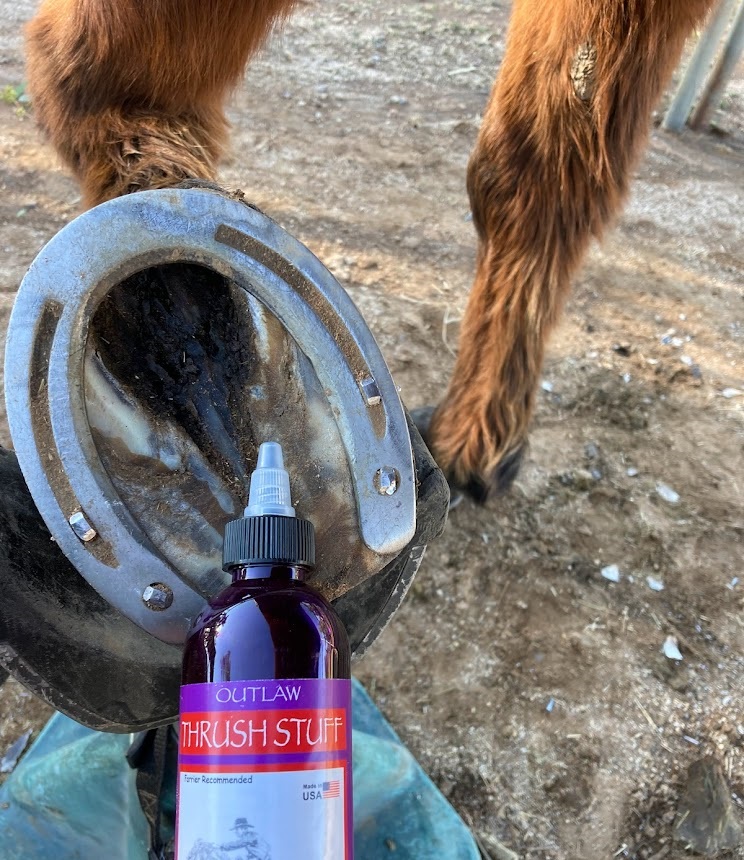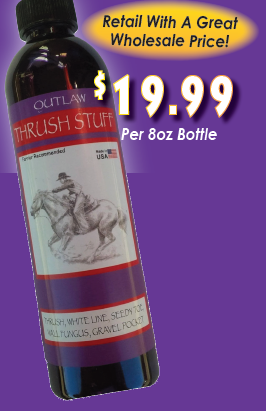The Outlaw Thrush Stuff Product
The Outlaw Thrush stuff is made to treat and prevent thrush in horse hooves because no other product on the market worked for my clients.
I am a farrier of thirty-two years and have been telling clients to pick out their feet. But the topical thrush treatments on the market weren’t working. I was fooling myself, thinking it was a lazy client or just dumb luck that certain horses are prone to thrush because of hoof or stall conditions, which are also environmental conditions.
So I made it my mission to make a product that works not sometimes but every time. I have been using it for twenty years and recommending it for twenty years. Now I have the opportunity to offer it to everyone and their horses.



The Outlaw Thrush Stuff is applied directly to the infected area.
The Benefits of Using Outlaw Thrush Stuff
That’s where Outlaw Thrush Stuff comes in. The product is effective at all stages of thrush. Outlaw Thrush Stuff will treat the worst cases of thrush or be gentle enough for routine hoof maintenance. As an antiseptic, it treats the root cause, and as an astringent, it changes the moisture in the hoof tissue to stop reinfection of the compromised tissue. So this allows healthy tissue to grow, creating a sound and functional hoof.
The Outlaw Thrush Stuff will not burn or sting the sensitive tissues of the frog or heels, which makes it easier to apply to sore feet. The product should be your go-to treatment for horses with thrush. Every conscientious horse owner should have the Outlaw Thrush Stuff on hand to treat thrush.
The Product Details of Outlaw Thrush Stuff
The Outlaw Thrush Stuff was uniquely designed as a treatment that will not sting or hurt the sensitive tissues of the horse’s hoof. When thrush is present, it compromises the tissue of the frog, the sulcus of the hoof, the plantar cushion, and possibly all aspects of the hoof function.
When a horse has thrush, the hoof is extremely sensitive at this point to cleaning, pressure, and picking out manure. Extreme caution should be made not to injure the sensitive tissues any further. The active ingredients of Outlaw Thrush Stuff have been used in dermatology for decades with great results and no sting or ill effects.
We have formulated Outlaw Thrush Stuff to be gentle, non-stinging, and effective for horses’ hoofs in all stages of infection. It can also apply to thrush near open raw tissue without hurting or stinging the horse or, in minor cases needing help. When your horse needs treatment, the only one to turn to is the Outlaw Thrush Stuff, a product that has been tested, proven gentle, and effective.
Factors in the growth of thrush in horses:
Treatment for horses with thrush. Certain factors go into the conditions to allow thrush to thrive in a horse hoof. Let’s go over some of them. Thrush is an anaerobic bacteria that lives in all dirt. So this is the absence of oxygen that this bacteria will thrive in, and moisture is vital. Okay, now we know what it is and how it can grow in a hoof.
Horses stand in manure, urine, and dirt that gets packed into the hoof. A well-functioning hoof will shed the dirt that packs in the hoof, allowing oxygen to kill the exposed surface thrush. Compared to walking, running, or turning your horse when the horse is standing in the stall, there is insufficient movement to clean the bottom of the hoof and oxygenate the tissue. So this is why farriers say to pick out your hoof regularly.
Why does my horse have thrush? His stall is clean and extremely dry; what is causing him to have thrush? Simple, you ride in the dirt, a horse’s hoof has internal moisture, and you have the perfect combination for thrush.
Thrush problems for horses can be caused by poor hygiene, moisture, dirt, and possibly the health of the hoof. It’s challenging to realize the seriousness of something that appears so subtle, but due to the horse’s hoof construction, it can be dangerous if not dealt with properly with Outlaw Thrush Stuff. Horse hoof thrush can cause excruciating pain and lameness.
Thrush is relatively easy to diagnose based on the telltale dark, blackish discharge and foul odor similar to yeast or spoiled bread rising odor. The bacteria breaking down the hoof tissue can lead to pain in the hoof capsule, bruising, and general discomfort for the horse.
If you smell a foul odor while picking your horse’s feet, chances are he has contracted hoof thrush, a frog-eating, anaerobic bacteria. It would help if you treated with Outlaw Thrush Stuff the thrush in the horse’s hooves as soon as you notice the first sign of this menace.
As a farrier trimming the sole and frog is very important. It allows the hoof to work correctly, shedding dirt and manure, also allowing access to the hole frog and heels of the hoof to place Thrush treatment in reaching the infected sites, not just treating the manure packed in the hoof.
Steps to take in preventing Thrush in horses:
Move your horse to a dry, clean area. The first step in treating thrush is removing your horse from the environment where thrush tends to flourish. If you keep your horse in a wet or dirty environment, the thrush will likely return, no matter what treatment options you use.
- Thrush is usually developed on damp or dirty ground, whether in a stall, field, or pasture.
- Pick out urine, manure, and dirt daily. Horse waste can be a contributing factor in developing thrush in the hoof.
- Try spreading gravel or shavings on the ground. So this will allow your horse to keep its hooves dry, even if the floor of the stall or paddock is wet.
Trim the frog of the hoof
Once your horse is in a clean, dry area, you’ll need to
have the frog trimmed on the infected hooves. So this will get rid of the affected area and permit better air circulation across the hoof, allowing access to apply Thrush stuff and will improve the chances that the thrush will not return.
The use an antiseptic and astringent to clean the affected area
Now that you’ve removed the visible dirt and debris from your horse’s hooves, you’ll want to clean the affected area and treat it with Outlaw Thrush Stuff. Others suggest treating thrush with bleach. However, it’s worth noting that harsh chemicals can dry out your horse’s hooves, which may make them prone to further injuries and Infections. Outlaw Thrush Stuff is not harmful to the hoof tissues. Thrush Stuff is designed to penetrate the hoof’s nooks and crannies of the necrotic tissue, not sit on the surface as some powders do.
Maintenance of the hoof
Thrush in horse hoofs. After trimming the affected area of the frog, you’re ready to clean the hoof. Cleaning the hoof should become a daily part of your horse maintenance from now on, as it will help prevent injury and reduce the chances of thrush returning in the future. Be careful, though, as the horse may be in considerable pain, and cleaning out the affected hoof may hurt or anger your horse simply due to the discomfort involved.
- Use a hoof pick to pick out any larger debris from the affected area being careful not to dig too deep.
- At this point, you can pack the affected area with cotton to stop the material from being repacked in the hoof.
- Then apply Outlaw Thrush Stuff by squirting it into the sulcus of the hoof, which are the V-like indentations that make up the sides of the hoof’s frog.
- Always use clean gauze or cotton balls to the sulcus to cover the medication. Use a hoof pick to pack the gauze as deeply as possible into the sulcus without hurting the horse.
- Change the packing every day for one to two weeks. You should not have any medication or packing on the sulcus, only during exercise or riding sessions.
Depending on the severity of the infection, it could take several weeks for the hoof to heal completely. Be patient and keep the hooves clean and treated with Outlaw Thrush Stuff. The hoof will grow to protect the hoof.
We also recommend using a bar shoe after the thrush has
healed. If you previously used a standard horseshoe or no shoe on your horse’s hooves, consider switching to a bar shoe once the affliction has healed. In some cases, using a bar shoe has helped the frog regenerate after being trimmed and treated with Outlaw Thrush Stuff.
- A bar shoe is a horseshoe with joined heels. It forms a continuous circle, usually made of either aluminum or steel.
- Bar shoes can help improve ground contact, protect the hoof and frog, and stabilize the overall hoof, and should only be used in severe cases.
Look for signs of pain. You can usually tell when a horse has hoof thrush based on the way it walks and reacts when you clean the hoof. A horse with severe thrush infection will show pain whenever pressure is applied to the area, which may result in limping or lameness in severe cases.
In advanced cases of thrush, the lower limb may swell up because of the infection. If this happens, you must treat the thrush aggressively to ensure your horse can fully recover. Always consult a Veterinarian when lameness or swelling is present in your horse.
Give your horse some dry footing. Wet and dirty footing is one of the
leading causes of hoof thrush in horses. If you keep your horse outside in an enclosure and the ground is constantly wet, let your horse come into a barn or stable stall occasionally to allow the hooves to dry out. Keeping the stall and paddocks clean and dry is best.
- Muck out manure from the stalls and clean or dig out the urine spots daily.
- Spread gravel or shavings in the paddocks or on the stable floor so your horse can stand on dry footing, even when the ground underneath is wet.
Exercising your horse regularly along with function anatomy of the hoof
Regular exercise can help prevent thrush in horses. That’s because movement expands and contracts the hooves, which can push debris out of the grooves in the hooves. Even if you can’t turn out your horse in an enclosure, hand-walking or riding on dry ground can significantly reduce the chances of thrush developing. Thrush is a bacterial infection in the frog’s tissue, the “V” shaped structure located between the sole, wall, and bars in the heel area of the hoof.
The disease begins when bacteria penetrate the outer horn tissue of the frog. As it progresses, the frog tissue deteriorates, looking uneven
and ragged and producing a smelly discharge and odor. In severe cases, the bacteria can reach the inner tissue of the frog; this is the sensitive tissue beneath the frog, causing pain and lameness. You may even notice blood on the end of the hoof pick when cleaning the frog. The frog has two distinct layers: the horn tissue and the underlying vascular layer of tissue called the sensitive corium.
Beneath the sensitive layer lies a pad-like shock absorber that reduces
concussion for the horse’s hoof and entire limb, called the deep digital
cushion. A healthy, well-formed frog is broad and fleshy. A healthy frog shares the load-bearing function with the other hoof structures and helps absorb concussion. So this, in turn, stimulates ongoing frog health and blood flow.
A well-shaped frog also has a natural self-cleaning mechanism. When it comes into contact with the ground, it expands, pushing accumulated dirt and debris out of the frog sulci, the grooves on either side of the frog.
An unhealthy frog is recessed, shrunken inward from the surface level of the rest of the hoof, and more minor than it should be. So this can occur for various reasons, including genetic abnormalities like clubfoot and farrier issues like a horse with sheared or high low heel sindrom.
The fundamental problem usually involves the frog and the heels of the hoof capsule not being on or close to the same plane as the frog. So this limits the frog’s contact with the ground and can reduce the stimulation from the ground surface, causing the frog to atrophy. The recessed frog does not share in supporting the horse’s weight, so it shifts too much of the load-bearing back onto the heels of the hoof capsule.
Your farrier will also treat the thrush infection like a dirty wound, trimming away the loose, diseased frog tissue and applying Outlaw Thrush Stuff. Once the frog is back on the same plane as the rest of the hoof, it will become healthy and heal quickly.
Thrush will likely take over a hoof left in unsanitary conditions. A wet environment consisting of urine and decomposing manure is a breeding ground for the anaerobic bacteria attracted to any dead compromised tissue on the horse’s frog. The bacteria will form deep-seated pockets and drill into the frog and dead tissue, eating away at the remaining healthy tissue.
Despite what some people think, thrush is not caused directly by unhygienic conditions. It only develops in horses with unhealthy frogs or compromised hoofs. You can put a horse with healthy frogs in the worst possible conditions, for example, an excessively damp, dirty stall, and he will rarely get thrush. On the other hand, some of the best-cared-for horses get thrush, despite their immaculate surroundings because their frogs aren’t healthy, and you have the right conditions for thrush to thrive.
Why our active ingredient is safe and effective
Our active ingredient is Potassium based, first made in the 1600s and came into everyday medical use at least as early as the 1800s. It is on the World Health Organization’s List of Essential Medicines.
The World Health Organization’s Essential Medicines List contains the
medications considered most effective and safe to meet the essential needs of a health system. Countries frequently use the list to help develop their lists of essential medicines. Our active ingredient is listed under dermatological medicines (Topical).
It is used as a medication for several skin conditions. This includes fungal infections of the foot, impetigo, pemphigus, superficial wounds, dermatitis, and topical ulcers. We have described some uses in human dermatology. We do not recommend any other product use other than on the label. Our product was designed for Equine use only and is never intended for human use. We are just trying to show the effectiveness of the product and that it has been around for decades with effective results.